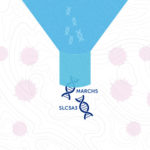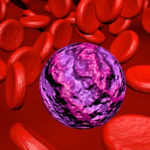How a leukemia hijacks the genes needed by blood stem cells

As a child, Lynn Aureli didn’t know that a particular genetic change contributed to her acute myeloid leukemia (AML) — an alteration that eventually would help explain the cancer’s lack of response to chemotherapy. Nor was she aware that her cancer had hijacked the genetic mechanism for maintaining the stem cells that form blood, like those in the bone marrow transplant that saved her life.
A decade after her diagnosis and treatment, Lynn’s mutation — found in about 10 percent of people with AML — enabled researchers at Dana-Farber/Boston Children’s Cancer and Blood Disorders Center to gain insight into how normal stem cell production is controlled and how cancers can take advantage of the same process. The study, led by Richard A. Voit, MD, PhD, Liming Tao, PhD, and Fulong Yu, PhD working in Vijay Sankaran, MD, PhD’s laboratory, was published in Nature Immunology on December 15.
AML’s impact on blood cells
AML is a type of cancer that arises when blood stem cells cannot mature into healthy blood cells. Instead, immature blood cells build up in the bone marrow and prevent the development of healthy white blood cells, red blood cells, and platelets. This prevents people from being able to fight off infections and can cause anemia and bleeding.
Unexplained soreness in Lynn’s arm at a One Direction concert just one week before her 16th birthday was the first clue to her AML diagnosis. Lynn’s parents, who lived in Connecticut at the time, brought her to a local emergency room when her arm began to swell. There, doctors diagnosed Lynn with a blood clot. More concerning, her blood work revealed that she had a surprisingly high number of white blood cells, leading to the diagnosis of AML.
After Lynn was diagnosed, it took four rounds of chemotherapy and an experimental drug for enough of her cancer cells to be eliminated to proceed with a bone marrow transplant. At the time, Lynn’s doctors didn’t know that the aggressiveness of her AML was caused by a particular genetic change that is now known to make AML very difficult to cure.
Connecting stem cell genes and AML prognosis
A couple of years after her successful bone marrow transplant at Dana-Farber/Boston Children’s, scientists discovered that a gene known as MECOM is more active in some people with AML, including Lynn.
MECOM tells cells to make a protein that turns on certain genes at specific times during blood cell development. In rare cases when MECOM isn’t active enough, people lose all of their blood stem cells and cannot produce enough blood cells. As a result, they, like Lynn, require a bone marrow transplant from a healthy donor to survive.
In their recent study, Dr. Voit and colleagues wanted to understand how exactly MECOM affects the maintenance of blood stem cells. They found that human blood stem cells with less MECOM expression were not able to remain as stem cells, instead being forced to develop into mature blood cells all at once. This explains how reduced MECOM activity causes a complete loss of stem cells and led the team to wonder what other genes might be regulated by MECOM to maintain blood stem cells.
During their analysis, the researchers figured out one way MECOM contributes to AML: The very same genes that MECOM normally controls are in overdrive in leukemia. They also analyzed gene expression information from adults and children with AML and found that people with higher levels of the genes regulated by MECOM had worse prognoses.
“High-risk leukemias adopt features of blood stem cells that make them really aggressive and resistant to chemotherapy,” explains Dr. Sankaran. “But normal stem cells saved Lynn’s life.”
Targeted treatments for leukemia?
Although our understanding of MECOM arrived too late to change Lynn’s course of treatment, she was inspired by the nurses who cared for her as a kid and hopes to pay that inspiration forward. She is now an oncology nurse at the Dana-Farber Cancer Institute and wants other people to know that there is a light at the end of the tunnel during treatment. “It can seem like it is endless, but you will get through it one day at a time,” she reflects.
Meanwhile, the genetic changes found in Lynn’s type of leukemia have helped scientists determine what the genes controlled by MECOM do and how those genes affect stem cell function. This could lead to a better understanding of how to maintain blood stem cells outside of the body, like when they are being prepared for a bone marrow transplant.
Sankaran and Voit also hope that this work brings them one step closer to developing new treatments for AML. “All drug discovery starts with a fundamental understanding of a biological mechanism,” says Dr. Voit. “My hope is that in the future we can directly target a pathway downstream of MECOM in leukemias to treat patients more effectively and with fewer side effects.”
Learn why we are #1 in pediatric cancer care or refer a patient.
Related Posts :
-

Can we prevent leukemia in patients with Shwachman-Diamond syndrome?
Anna Nazarenko doesn’t see herself as sick. The strong-willed, spunky 6-year-old loves to dance and ski, and spent much ...
-

Too many blood cells: Probing a blood cancer’s genetic origins
At age 7, Meredith Shah began having debilitating migraine headaches. “I would have trouble seeing and shapes were blurry,” she recalls. “...
-

Finding new targets for acute myeloid leukemia in children
Acute myeloid leukemia (AML) is the second most common leukemia diagnosed in children. It is hard to treat and can ...
-

Could leukemia be stopped before it starts?
Acute myeloid leukemia (AML), a blood cancer affecting both adults and children, requires more than one genetic “hit” to develop. ...





